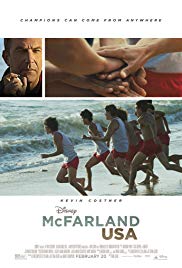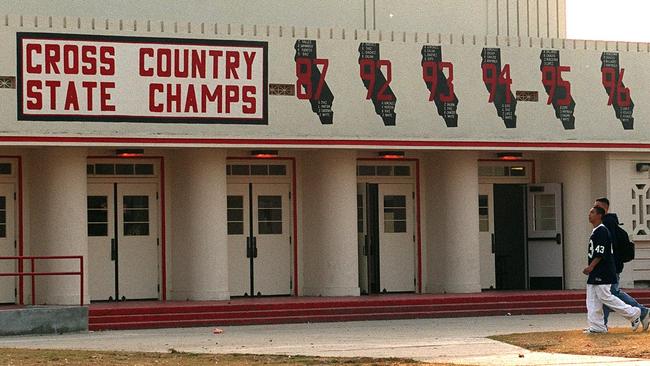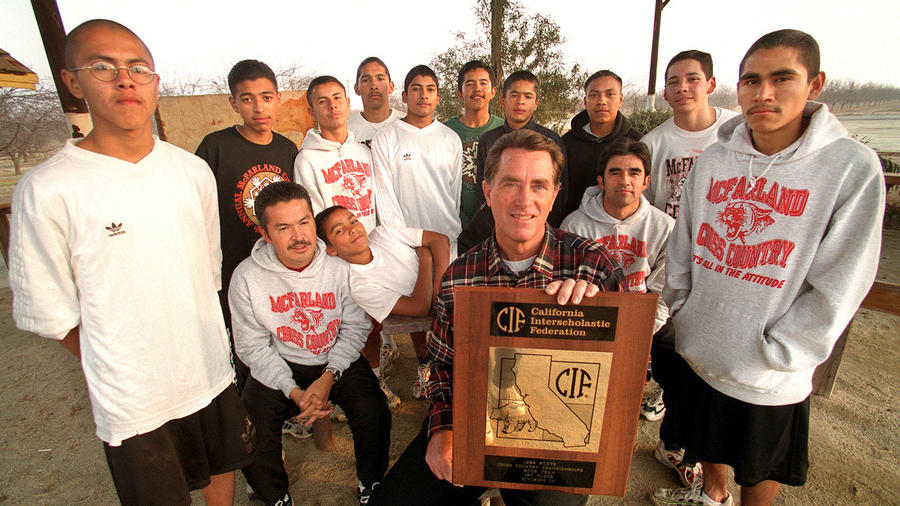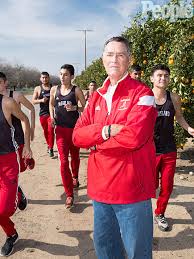McFARLAND, USA
SUBJECTS — Sports; U.S. 1945 – Current, Hispanic, & California;
SOCIAL-EMOTIONAL LEARNING — Education; Breaking Out;
MORAL-ETHICAL EMPHASIS — Responsibility.
AGE: 12+; MPAA Rating — PG;
Drama; 2015, 129 minutes; Color.
There is NO AI content on this website. All content on TeachWithMovies.org has been written by human beings.

SUBJECTS — Sports; U.S. 1945 – Current, Hispanic, & California;
SOCIAL-EMOTIONAL LEARNING — Education; Breaking Out;
MORAL-ETHICAL EMPHASIS — Responsibility.
AGE: 12+; MPAA Rating — PG;
Drama; 2015, 129 minutes; Color.

This movie is based on the remarkable McFarland High School Cross-Country Team which, until it was recently forced to compete against much larger schools, dominated its division in the sport state-wide for more than 20 years.
Located in California’s agriculturally rich San Joaquin Valley, McFarland is one of the poorest communities in California. Its high school students are the children of Hispanic “pickers,” farmworkers paid low wages for back-breaking work in the fields — actually, some of the students work in the fields themselves before school, after school, and on the weekends. It turns out, that some of the students run to and from school and the fields each day and . . . they are really fast.
The film is “based on a true story” of the first McFarland championship team and how the discipline that the students learned in running and the boost to their self-esteem from winning against students from wealthier more advantaged schools allowed the students to go to college and achieve more in their lives than they had ever dreamed possible. The film also presents a fictional tale of the coach who lead the team to victory.
Selected Awards: None.
Featured Actors: Kevin Costner as Jim White; Ramiro Rodriguez as Danny Diaz; Carlos Pratts as Thomas Valles; Johnny Ortiz as Jose Cardenas; Rafael Martinez as David Diaz; Hector Duran as Johnny Sameniego; Sergio Avelar as Victor Puentes; Michael Aguero as Damacio Diaz; Diana Maria Riva as Señora Diaz; Omar Leyva as Señor Diaz; Valente Rodriguez as Principal Camillo.
Director: Niki Caro.
This film shows Hispanic kids excelling in sports and using their success at running as an opening to achievement beyond the fields of vegetables and fruit in which they grew up and in which they and their parents worked. It shows the hard lives of agricultural laborers in the U.S. and the close Hispanic communities of America’s Southwest. The movie also contains the fictional, but a believable tale, of an adult, suffering from mistakes of judgment who keeps on trying, looks for opportunities, and turns his life around. All of the families shown in this film are close and functional.
Students will be exposed to the beneficial stories described in this film. The benefits of tolerance, inclusion, perseverance, teamwork, hard work and family cohesion will be shown by the film.

Before showing the film, on a map show the class the location of the San Joaquin Valley towns of McFarland and Delano (where Cesar Chavez started the National Farm Workers). Tell students, “A lot of what happened to the character of the coach in this movie was invented by the filmmakers to give the story more drama. There is a real coach White who worked at the high school in McFarland. His story, which I’ll tell you after the movie is over, is also pretty interesting. The character of Coach White in the film is a middle-aged man with a family. However, there is a lot that we can all learn from this character. Think about it as you watch the movie and afterwards we’ll talk a little about the character in the film and the real Coach White.”
Then ask the students to look for product placement in the movie. “Companies lobby filmmakers and some even pay to get their products shown in movies. As you watch this film, ask yourself, “Which brand-named product is featured? In which scenes is it shown? How is this designed to influence your buying decisions?”
Start with Discussion Questions 1 and 2. Then tell the class about the real Coach White, as follows:
Coach White taught in McFarland schools beginning in 1964, the year he graduated from college. He started by teaching science to fifth graders. After nine years, he taught seventh and eighth-grade woodshop and PE. After 11 years of doing that, he taught PE exclusively and coached the high school cross-country team. Coach White had not been fired from any previous jobs and had not thrown a shoe at an insolent student. When Coach White started to teach in McFarland, it was a primarily white community. By 1987 that had changed. He retired in 2003 after teaching in McFarland for 29 years.
Mr. White coached both the girls and the boys cross-country teams. Before 1987, there had been a cross-country team at McFarland High, but it was not outstanding, and in 1986, cross-country track wasn’t even offered at the school. Coach White restarted the cross-country team in 1987 and rebuilt it from the ground up. The McFarland High students dominated California’s cross-country track winning 25 titles in 27 years. However, because of its succes,s it is now being required to compete against larger schools and in 2015 didn’t make it to the state championships.
Coach White did, in fact, find one of his star runners, Thomas Valles, out late one night near a bridge after a bad fight between the boy’s parents. The coach talked Valles into his truck and listened to the boy’s troubles.
The kids really did call Coach White “blanco.” It is true that Coach White on occasion worked in the fields alongside his students. He said in an interview that:
Sometimes I helped them work in the fields, but more importantly, I had practice at a different time. If one or two of those boys couldn’t make practice at four o’clock ’cause they’re just gettin’ in from work, then I might practice at 6 or 7 o’clock with those boys. So I’d have two practices.-KGET 17
Sports Illustrated magazine has this to say about Coach White, “He rarely raised his voice. He’d stumbled upon the sorcerer’s stone of coaching: Give so much of yourself that your boys can’t bear to let you down.” Running For Their Lives: The story that inspired ‘McFarland, USA’ by Gary Smith, 2/16/15, Sports Illustrated Magazine
To follow up about the featured brand named product, ask discussion question #3.
How did the parents of these children change from being migrant workers to homeowners residing in McFarland full time and working in the fields? This is how it was described for the family of one runner.
[His father] said the decision to end the life of a migrant and bring his family to California for good was not easy. Like thousands of others who have left [Mexico] for McFarland, he was nudged by Mexico’s deep poverty and the U.S. amnesty law that granted his family legal status in 1987. The shadow of the late Cesar Chavez, whose union improved wages and conditions in the fields, helped ease the way. So, too, have a booming farm economy and new crops that extend the harvest from early spring to late autumn.
With the earnings of an older married son and Jose Jr., the parents scraped together a small down payment and bought their rundown stucco house for $62,000. Ten family members, children and grandchildren, share quarters. They survive on $20,000 a year in minimum wages. Column One Grueling season: McFarland cross-country team toils for the 6th straight title by Mark Araz, LA Times, 12/1/1997
While many of the boys from McFarland’s cross-country teams were able to go to college, others didn’t make it out of the fields and are spending their lives cutting grapes, picking oranges, shelling almonds and harvesting the other crops that appear on American tables.
Something not shown in the film is that veterans from past teams who stayed in McFarland would come out and run with the team. They were a great resource for the boys and coach White, encouraging the boys and helping when there was a crisis.

After showing the film to students, engage the class in a discussion about the movie.
1. What did you learn from this movie other than from the character of Coach White? We’ll get to Coach White in a minute.
Suggested Response:
There is no one correct response. A good way to organize the responses is that they will be either about young people, Mexican-Americans, or about the country as a whole. Good responses include: 1) farm labor is very, very hard; 2) if you apply yourself, you can achieve great things; 3) families should stick together, even in hard times like the families of the workers and the coach’s family; 4) there is a great value in Hispanic culture, especially in the strength of the family; 5) our country works best when there we accept people of all different cultures and combine together to be Americans, like coach White and his students.
2. How would you describe the character of Coach White in the film, not the real Coach White but the character who was invented by the scriptwriters?
Suggested Response:
There are many ways to say this. The Coach White character didn’t give up when he was down. He kept on trying. After throwing the shoe at the insolent student, he treated everyone with care and respect. He was able to admit his mistakes even to others and try to do better.
3. Which brand-named product was featured in this film? In which scenes is it shown? How is this designed to influence your buying decisions?
Suggested Response:
It seems to be Coca-Cola. Mr. White is seen drinking it at least twice. On one of those occasions, is dehydrated and needs something to re-hydrate himself. There are many products, including water, which would have been better for this purpose and less harmful than Coca-Cola.
4. What is the most remarkable thing about the story of the McFarland High School Cross-Country Team, the coach or the success of the boys who have made up the teams?
Suggested Response:
They are both quite remarkable. The coach is a role model for a great teacher. He gave of himself, fully, year after year, with sensitivity and insight. The fact that the boys were able to learn and profit from his coaching and that many of them went to college and later worked in jobs their parents could only dream about, is the most important story. Hopefully, this type of inspiration of young people is something repeated in the U.S. and other countries in sports and education year after year.
5. What did the boys learn from their experience running for the McFarland High School Cross-Country Team?
Suggested Response:
They learned the value of discipline and that with hard work they could compete with and beat students from wealthier and more privileged backgrounds.
6. This movie has been criticized as being another in the long line of “White Savior” movies, in which minorities benefit from the intervention of whites. What is your reaction to this criticism?
Suggested Response:
First, it is true that the real Coach White was a facilitator by which the boys saved themselves. No one made those boys run mile after painful mile in the blistering heat. The point is, you cannot save anyone who doesn’t want to be saved. The savior is only the facilitator. The true hero is the person who takes the facilitator up on his offer and does the hard work. An interesting thing about this story with the fictional Coach White is that the boys saved him, as much as he saved them. So, it’s not a classic “white savior situation.”
A Reflection on non-White saviors in American History Dr. Martin Luther King and Cesar Chavez are both non-white saviors of white Americans. Dr. King and the Civil Rights Movement, awakened the conscience of America to its own racism and the evils of segregation. He (and the Movement) were the facilitator for the recognition by whites that they had to change, that they had to improve themselves, that we had to improve as a country. Cesar Chavez facilitated the recognition that conditions for farmworkers were terrible and had to improve. Of course, the removal of racism and improvements for the farm workers are not complete efforts, there is some backsliding, but things have improved substantially in both of those areas from where they were before Dr. King and Cesar Chavez performed their facilitating, i.e., saving, work. And again, the extent that positive changes were made, the American people had to do the work within themselves to change.
7. What is responsible for the fact that this one small high school, year after year has so many good long distance runners?
Suggested Response:
There is no one correct answer of which TWM is aware. However, strong responses will include the following: long-distance running is a sport of endurance, where the athletes must endure fatigue and pain; the success of these students appears to be based on superior training (the consistent practices and the summer running, for example) and the fact that their tedious, hot, and painful work in the fields, hour after hour, forced them to learn how to endure physical discomfort; this combined with the natural talent of some of the runners seems to have made the teams successful.
See Discussion Questions for Use With any Film that is a Work of Fiction.
Any of the discussion questions or the questions on the Film Study Worksheet for a Work of Historical Fiction can serve as a writing prompt. Additional assignments include:
1. [This assignment is for strong readers. There are two really excellent articles that have been written about the McFarland Cross-Country Team and Coach White. The articles are available on the Internet and linked in the Bridges to Reading Section below.] Read, compare, and contrast the style and the content of the following two articles on the McFarland Cross-Country Team. Then write out the three most interesting facts set out in these articles and describe why you found them to be interesting. The two articles are: (1) “Column One Grueling season: McFarland cross-country team toils for 6th straight title” by Mark Arax, LA Times, 12/1/1997; and “Running For Their Lives: The story that inspired ‘McFarland, USA'” by Gary Smith, 2/16/15, Sports Illustrated Magazine.
2. Describe three major lessons that the filmmakers were trying to impart through this story: one relating to the students, one relating to the coach, and one relating to the United States as a whole.
3. Based on Internet research [or based on the class discussion] make a list of three important facts that the screenwriters changed. Then, for each fact that you listed, describe why you think the filmmakers made the change in terms of the needs of creating an interesting and emotionally appealing story.
4. Research and write an essay describing the current status of farm laborers in California.
See also Additional Assignments for Use With any Film that is a Work of Fiction.
The story of the McFarland cross-country track teams has inspired some excellent journalism. Here are two examples of the best.
The two articles listed in the Bridges to Reading Section and
Multimedia: Anchor Standard #7 for Reading (for both ELA classes and for History/Social Studies, Science, and Technical Classes). (The three Anchor Standards read: “Integrate and evaluate content presented in diverse media, including visually and quantitatively as well as in words.”) CCSS pp. 35 & 60. See also Anchor Standard #2 for ELA Speaking and Listening, CCSS pg. 48.
Reading: Anchor Standards #s 1, 2, 7 and 8 for Reading and related standards (for both ELA classes and for History/Social Studies, Science, and Technical Classes). CCSS pp. 35 & 60.
Writing: Anchor Standards #s 1 – 5 and 7- 10 for Writing and related standards (for both ELA classes and for History/Social Studies, Science, and Technical Classes). CCSS pp. 41 & 63.
Speaking and Listening: Anchor Standards #s 1 – 3 (for ELA classes). CCSS pg. 48.
Not all assignments reach all Anchor Standards. Teachers are encouraged to review the specific standards to make sure that over the term all standards are met.
See the web pages referred to the Bridges to Reading Section and the Links to the Internet Section. Also, selected film reviews listed on the Movie Review Query Engine were consulted.